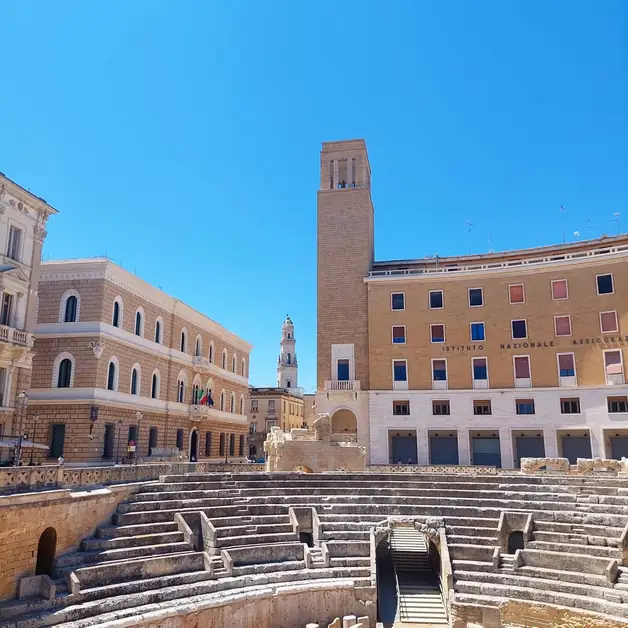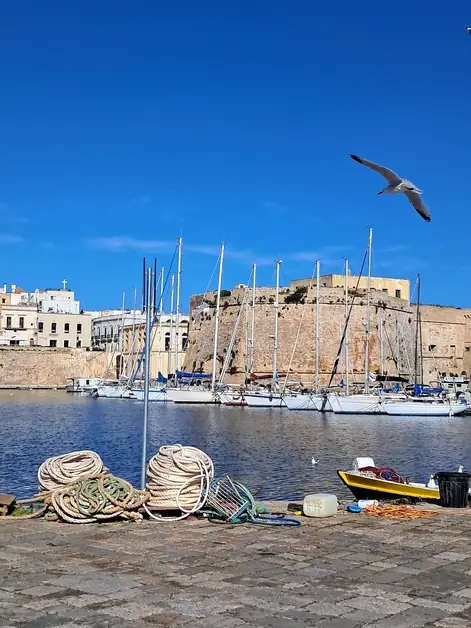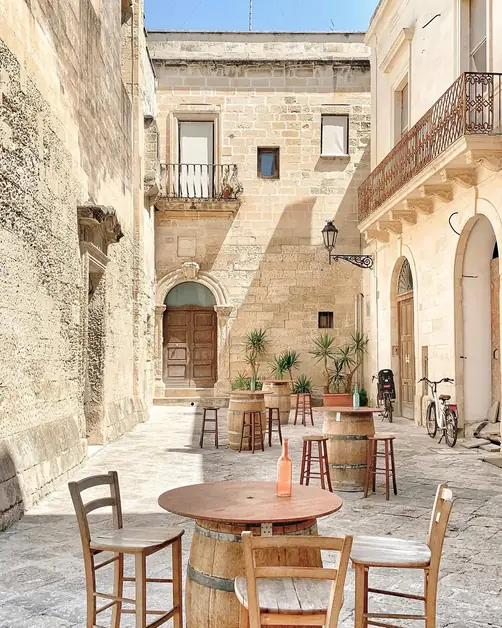Explore the Roman Amphitheater of Lecce and its history
Visit the Roman amphitheater of Lecce and discover its fascinating history.

Where is the Roman amphitheater of Lecce and how do you reach the stone steps?
The Roman amphitheater is located in the historic center, in Piazza Sant’Oronzo, the main square of the city. It is impossible not to notice it: it emerges next to the column dedicated to the patron saint and in front of the Palazzo del Seggio, in an area that today represents the beating heart of Lecce.
Those arriving on foot from the train station can reach it in about 15 minutes along Viale Oronzo Quarta and Via XXV Luglio. Along the way, you will encounter cafes, shops, and historic buildings that accompany you to the square.
How to get to the Roman amphitheater by car and where to park in Lecce?
The historic center is largely a restricted traffic zone, so it is not possible to drive to Piazza Sant’Oronzo. Those traveling by car must leave their vehicle in nearby parking lots.
Among the recommended free parking areas are Via Bernardino Realino and Via Miglietta, both about 10-15 minutes on foot from the center. For those preferring larger solutions, Foro Boario and Largo Settelacquare offer hundreds of spots, although they are 15-20 minutes on foot away. If you want to park closer, there are paid parking lots near Porta Napoli and along Viale dell’Università.
What is the origin of the stone steps of the Roman amphitheater of Lecce?
The amphitheater was built in Roman times, probably between the 1st and 2nd centuries AD, a period of great prosperity for the ancient city, then known as Lupiae. The stone steps were carved from local blocks and allowed for thousands of spectators. It is estimated that the capacity was between 15,000 and 20,000 seats, a surprising number considering the size of the city at that time.
The steps were organized into sectors based on social hierarchy: authorities and important citizens sat closer to the arena, while the higher seats were reserved for the common people.
What kind of shows took place in the amphitheater of Lecce during Roman times?
The amphitheater was mainly used for gladiatorial games, animal fights, and public performances. It was a place of entertainment but also of social cohesion, where the entire population could participate in events.
Sitting today on the stone steps, visitors can imagine the crowd cheering for the shows, the applause, the sound of drums, and the chatter of people filling the arena. This experiential dimension makes the visit particularly engaging.
What is the feeling of sitting on the stone steps of the Roman amphitheater of Lecce?
Sitting on the steps means touching two thousand years of history. The stone, smoothed by time, conveys a sense of solidity and continuity. Looking down gives the impression of reliving the perspective of Roman spectators.
The modern square surrounding the amphitheater creates a suggestive contrast: on one side, the noise of the contemporary city, on the other, the silence of the ancient stone that tells a distant past.
How much of the Roman amphitheater of Lecce is visible today?
Much of the amphitheater is still buried beneath the surrounding buildings. What can be admired today is about a third of the original structure, uncovered in the 20th century during excavation work. Despite this, the visible steps and part of the arena allow for a clear idea of the grandeur of the work.
The rest lies hidden beneath Piazza Sant’Oronzo and under the buildings that have been constructed over the ancient ruins over the years.
What is the best time to visit the steps of the Roman amphitheater of Lecce?
During the day, the amphitheater is easily accessible and well visible, but it is in the evening, with the scenic lighting, that the stone steps take on a particular charm. The artificial lights enhance the contrasts of the stone and create a suggestive atmosphere, especially in summer when the square comes alive with events and tourists.
Many choose to observe the amphitheater from above, strolling along the square, but there are also guided tours that allow you to get closer to the steps.
What other monuments are located near the Roman amphitheater of Lecce?
Next to the amphitheater stands the column of Sant’Oronzo, almost 30 meters high, a symbol of the city. Not far away, you can visit the Castello Carlo V and the Church of Santa Maria della Grazia, examples of different eras that testify to the historical stratification of the city.
Walking through the side streets, you can easily reach Piazza Duomo and the Basilica of Santa Croce, completing an itinerary that unites Roman antiquity with Lecce's Baroque.




